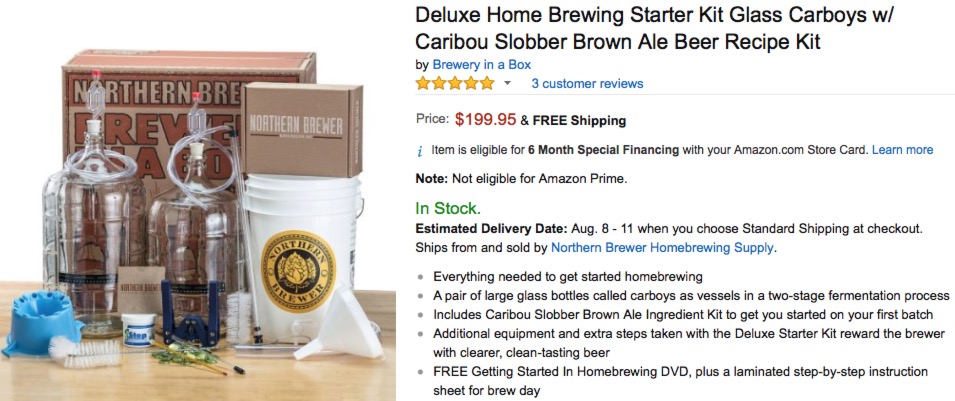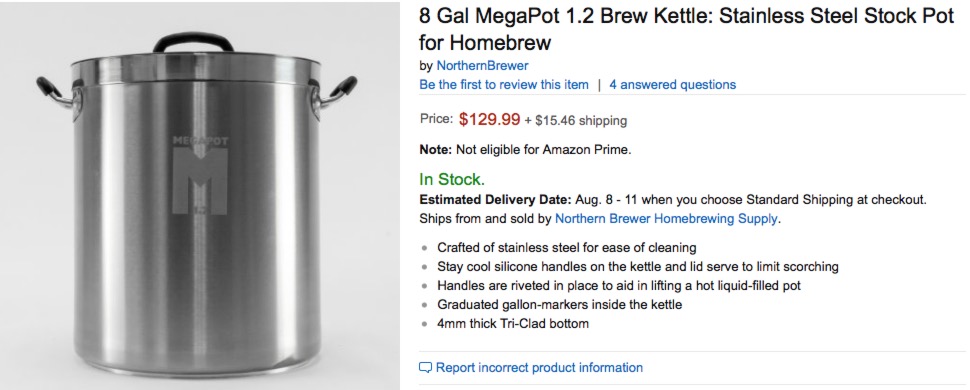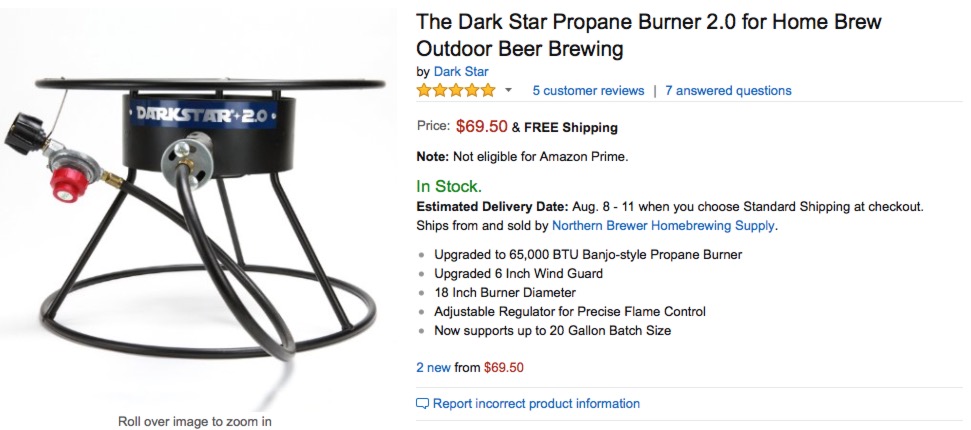Ad Disclosure
Crossing Brew: A Lanky Blogger’s Misadventures in Brewing Beer
By Kyle Scott
Published:

I’ve wanted to brew my own beer for several years now, but the large closet masquerading as a full-sized house that I lived in for the past four years – sans basement, garage or even proper air-conditioning – presented a challenge that was too great to overcome. I would’ve had to boil the wort five feet from where the beer would ferment, which would’ve been only seven feet from where I watched TV, two feet from the door, and entirely too few feet away from anything that would prevent my wife from killing me by drowning me in my own product in much the same way Judge Doom met his demise in Who Framed Roger Rabbit?
Anyway, I’ve moved and now have the room to brew without fear of a domestic homicide that the surrounding community would shrug off as an isolated incident and not consider it an indication of some greater public concern. And both because no homebrewer would be doing his craft a service if he didn’t cram his hobby down your throat like a drunken keeper-league fantasy football player and writing about it will allow me to expense this sudsy habit, I shall chronicle my misadventures.
First up: Proper Prior Preparedness.
As I’ve quickly come to learn, brewing your own beer can be as simple or as complex as you want to make it. You can buy a $50 kit and brew up a genuine ale using extracts and pre-packaged ingredients, or you can dedicate an interior room of your house as a sanitized home-brewing safe zone with precise temperature controls to brew up your organic kumquat IPA aged in bourbon barrels whittled from the hull of the Botafogo. Most of us will split the difference.
Keep in mind that what follows is my rudimentary understanding of a process on which I’ve spent a fairly reasonable amount of time researching, reading about, and watching YouTube videos. I imagine some purists will take exception to my interpretation of [insert part of beer-making process], and that’s OK! I’m inviting you inside my learning process. So come inside with me.
Equipment
My guess is that most beer people consider the $50 Mr. Beer kit you can get just about everywhere to be on par with using a Foreman Grill to cook up a tender steak. Sure, it’s easy and cheap and will get you STEAK, but you’re bastardizing the process and could produce a much better version with just a basic grill that most people have in their backyard. Or, you could buy a Big Green Egg and cook dry-aged porterhouses from cows that you watched your local butcher kill on a Facebook Live snuff stream. Once again, you’ll probably want to be somewhere in-between the Foreman and cooking a pampered cow on a $1,000 grill. I opted for a deluxe starter kit from Northern Brewer, which seems to be one of the interwebs’ go-tos for homebrewing supplies. This one [product links in this post are affiliate links, so should you decide to come along on this journey with me, you’ll be helping to fund my hobby]:
That gives me two glass carboys for fermentation, a bucket for bottling, funnels and siphons for transferring the liquid from one container to another, cleaning supplies, a bottle capper, and ingredients for my first brew– a brown ale.
In addition, at minimum, you’ll need at least a five gallon kettle to cook the wort, and bottles and caps. The latter can come later, but you’ll need the kettle on Day 1 to cook the wort.
This is where I faced some hesitation. While any five gallon kettle you already have in the kitchen will do, I learned that to do any serious, all-grain brewing, you’ll need at least an eight gallon kettle.
[You see, most kits include ingredients for extract brewing, which skips the step of mashing the grain and uses concentrated malt extract for the brewing process. There’s nothing wrong with this necessarily, and it’s absolutely the way you want to start, but all-grain brewing is the more advanced method. It’s akin to making tea with an organic tea bag or using fresh tea leaves– either way you’ll get a great tea, but one is a more authentic experience. ]So why the eight gallon kettle for all-grain brewing? Extract brewing really only requires you to boil roughly three gallons of wort to make a five gallon batch, because you add two gallons of fresh water to the fermentation process, after the wort is cooled. You need the five gallon kettle to boil three gallons to prevent boil over. Similarly, all-grain brewing requires you boil all five gallons, a full boil, and therefore you need at least an eight gallon kettle to prevent a messy spill.
Eight gallon kettle it is. This one:
I’m not foolish enough to start with all-grain brewing, but I also don’t like to half-ass anything (except for maybe putting my clothes in the hamper and putting Jim on an actual payroll so he doesn’t have to wait for PayPal funds to clear before he can pay his rent and other assorted living expenses), so having a decent eight gallon kettle will allow me to step up to all-grain brewing, or just have a little more margin for error in extract brewing.
Great, Kyle, so you got all of the stuff you need and can just put the kettle on the stove and get brewing, you fucking wannabe hipster! You’re so cool.
That’s what I thought.
As it turns out, placing an eight gallon kettle of boiling wort on a stovetop in a kitchen that you share with another human, particularly your wife, who would prefer that her kitchen not smell like a brewhouse (at best) or turn into a sticky crime scene as if someone killed the Stay Puft Marshmallow Man with a blowtorch should you have a boil over (at worst), you’ll want to cook outside. So, I bought an outdoor burner for boiling the wort. This one:
That’s it?
For now, yes, that should do. I will eventually need to buy bottles and caps, but they won’t be needed for a few weeks.
The Process
Sixers fans just got hard.
I will go into more detail in subsequent posts, but for this first batch – I will brew on Saturday – my process will be fairly straightforward: I’ll boil three gallons of wort outside, immediately transfer the kettle to an ice bath in the laundry room, move it to the basement and transfer to the first fermenter with two gallons of fresh water. Two weeks later, I’ll move it to the second fermenter. A few weeks later, I’ll bucket it, bottle, and let it condition for a period of time before refrigerating and drinking. And then I’ll most likely puke it up because I forgot to sanitize something.*
*By all accounts, sanitizing EVERYTHING that comes in contact with your brew after the boil is the most important part of brewing beer.
The Brew
So what am I making? Well, as you can see, I’ll be brewing the standard brown ale that comes with the Northern Brewer kit. But, of course, being the marketer I am, there’s no way I’m not branding this brown bastard. It needs a name. A strong name. A name that says Crossing Brew. A name that punches you in the fucking face with its cleverness and leaves you wondering why its maker isn’t paid seven-figure advisory fees by multinational brands for this sort of expertise.
Lo, a brown ale – drinkable, dark beer – that will be ready just in time for football season needs a name that really drives home the seasonality and warms the gullet with thoughts of the turning seasons from scorchingly hot fuck you, to pleasantly cozy football weather. You should be standing in your living doing a third-down defense chant at the mere mention of its name. You spontaneously break out into E-A-G-L-E-S chants as you raise the beer in appreciation of the very bottle in your hand. FUCK YOU, DALLAS!
Taking all that into account, it seems almost obvious what the first Crossing Brew should be called: Boys of Fall, which happens to be the song Kenny Chesney invited the Eagles to join him on stage for the night of Riley Cooper’s infamous N-word incident, our biggest post ever. Boys of Fall Ale. No, BOFA. And to say Brown BOFA would be the perfect, slightly offensive reference to that evening is downplaying its brilliance. Of course, we could also be talking about BOFA deez truck nuts on Cooper’s car that night. So, that’s how we get: Crossing Brew Brown BOFA (Deez).

Sit back, relax, and don’t fight the urge to welcome this brown boy of fall as you suck down BOFA Deez.
Stay tuned for the brewing process next week.
Kyle Scott is the founder and editor of CrossingBroad.com. He has written for CBS Philly and Philly Voice, and been a panelist or contributor on NBC Sports Philly, FOX 29 and SNY TV, as well as a recurring guest on 97.5 The Fanatic, 94 WIP, 106.7 The Fan and other stations. He has more than 10 years experience running digital media properties and in online advertising and marketing.


